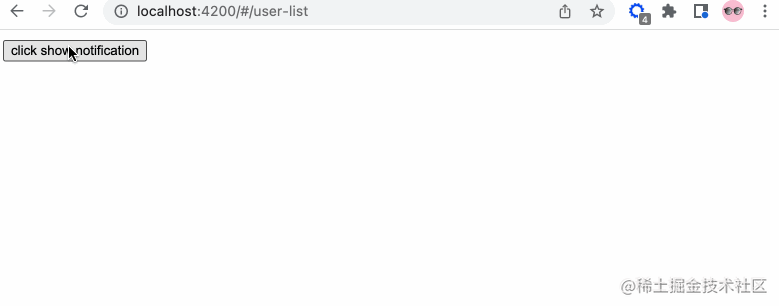Angular learning chat notification (custom service)
This article will take you to continue learning angular and briefly understand the custom service notification in angular. I hope it will be helpful to everyone!

In the previous article, we mentioned:
service can not only be used to process API requests, but also has other uses
For example, the implementation of notification we are going to talk about in this article. [Related tutorial recommendations: "angular tutorial"]
The rendering is as follows:

UI This can be adjusted later
So, let’s break it down step by step.
Add service
We add the notification.service.ts service file in app/services (please use the command Line generation), add relevant content:
// notification.service.ts
import { Injectable } from '@angular/core';
import { Observable, Subject } from 'rxjs';
// 通知状态的枚举
export enum NotificationStatus {
Process = "progress",
Success = "success",
Failure = "failure",
Ended = "ended"
}
@Injectable({
providedIn: 'root'
})
export class NotificationService {
private notify: Subject<NotificationStatus> = new Subject();
public messageObj: any = {
primary: '',
secondary: ''
}
// 转换成可观察体
public getNotification(): Observable<NotificationStatus> {
return this.notify.asObservable();
}
// 进行中通知
public showProcessNotification() {
this.notify.next(NotificationStatus.Process)
}
// 成功通知
public showSuccessNotification() {
this.notify.next(NotificationStatus.Success)
}
// 结束通知
public showEndedNotification() {
this.notify.next(NotificationStatus.Ended)
}
// 更改信息
public changePrimarySecondary(primary?: string, secondary?: string) {
this.messageObj.primary = primary;
this.messageObj.secondary = secondary
}
constructor() { }
}Is it easy to understand...
We will notify into an observable object, and then publish various statuses Information.
Create component
We create a new notification component in app/components where public components are stored. So you will get the following structure:
notification ├── notification.component.html // 页面骨架 ├── notification.component.scss // 页面独有样式 ├── notification.component.spec.ts // 测试文件 └── notification.component.ts // javascript 文件
We define the skeleton of notification:
<!-- notification.component.html -->
<!-- 支持手动关闭通知 -->
<button (click)="closeNotification()">关闭</button>
<h1 id="提醒的内容-nbsp-nbsp-message-nbsp">提醒的内容: {{ message }}</h1>
<!-- 自定义重点通知信息 -->
<p>{{ primaryMessage }}</p>
<!-- 自定义次要通知信息 -->
<p>{{ secondaryMessage }}</p>Then, we simply modify the skeleton and add the following style:
// notification.component.scss
:host {
position: fixed;
top: -100%;
right: 20px;
background-color: #999;
border: 1px solid #333;
border-radius: 10px;
width: 400px;
height: 180px;
padding: 10px;
// 注意这里的 active 的内容,在出现通知的时候才有
&.active {
top: 10px;
}
&.success {}
&.progress {}
&.failure {}
&.ended {}
}success, progress, failure, ended These four class names correspond to the enumeration defined by the notification service. You can add related styles according to your own preferences.
Finally, we add the behavioral javascript code.
// notification.component.ts
import { Component, OnInit, HostBinding, OnDestroy } from '@angular/core';
// 新的知识点 rxjs
import { Subscription } from 'rxjs';
import {debounceTime} from 'rxjs/operators';
// 引入相关的服务
import { NotificationStatus, NotificationService } from 'src/app/services/notification.service';
@Component({
selector: 'app-notification',
templateUrl: './notification.component.html',
styleUrls: ['./notification.component.scss']
})
export class NotificationComponent implements OnInit, OnDestroy {
// 防抖时间,只读
private readonly NOTIFICATION_DEBOUNCE_TIME_MS = 200;
protected notificationSubscription!: Subscription;
private timer: any = null;
public message: string = ''
// notification service 枚举信息的映射
private reflectObj: any = {
progress: "进行中",
success: "成功",
failure: "失败",
ended: "结束"
}
@HostBinding('class') notificationCssClass = '';
public primaryMessage!: string;
public secondaryMessage!: string;
constructor(
private notificationService: NotificationService
) { }
ngOnInit(): void {
this.init()
}
public init() {
// 添加相关的订阅信息
this.notificationSubscription = this.notificationService.getNotification()
.pipe(
debounceTime(this.NOTIFICATION_DEBOUNCE_TIME_MS)
)
.subscribe((notificationStatus: NotificationStatus) => {
if(notificationStatus) {
this.resetTimeout();
// 添加相关的样式
this.notificationCssClass = `active ${ notificationStatus }`
this.message = this.reflectObj[notificationStatus]
// 获取自定义首要信息
this.primaryMessage = this.notificationService.messageObj.primary;
// 获取自定义次要信息
this.secondaryMessage = this.notificationService.messageObj.secondary;
if(notificationStatus === NotificationStatus.Process) {
this.resetTimeout()
this.timer = setTimeout(() => {
this.resetView()
}, 1000)
} else {
this.resetTimeout();
this.timer = setTimeout(() => {
this.notificationCssClass = ''
this.resetView()
}, 2000)
}
}
})
}
private resetView(): void {
this.message = ''
}
// 关闭定时器
private resetTimeout(): void {
if(this.timer) {
clearTimeout(this.timer)
}
}
// 关闭通知
public closeNotification() {
this.notificationCssClass = ''
this.resetTimeout()
}
// 组件销毁
ngOnDestroy(): void {
this.resetTimeout();
// 取消所有的订阅消息
this.notificationSubscription.unsubscribe()
}
}Here, we introduce the knowledge point of rxjs, RxJS is a reactive programming library using Observables, which enables writing Asynchronous or callback based code is easier. This is a great library, and you’ll learn more about it in the next few articles.
Here we use the debounce anti-shake function, function anti-shake means that after the event is triggered, it can only be executed once after n seconds. If it is triggered again within n seconds event, the execution time of the function will be recalculated. To put it simply: when an action is triggered continuously, only the last time is executed.
ps:
throttleThrottle function: Limit a function to be executed only once within a certain period of time.
During the interview, the interviewer likes to ask...
Calling
Because this is a global service, we are Call this component in app.component.html:
// app.component.html <router-outlet></router-outlet> <app-notification></app-notification>
In order to facilitate the demonstration, we add a button in user-list.component.html to facilitate the triggering of the demonstration:
// user-list.component.html <button (click)="showNotification()">click show notification</button>
Trigger related code:
// user-list.component.ts
import { NotificationService } from 'src/app/services/notification.service';
// ...
constructor(
private notificationService: NotificationService
) { }
// 展示通知
showNotification(): void {
this.notificationService.changePrimarySecondary('主要信息 1');
this.notificationService.showProcessNotification();
setTimeout(() => {
this.notificationService.changePrimarySecondary('主要信息 2', '次要信息 2');
this.notificationService.showSuccessNotification();
}, 1000)
}At this point, we are done, we have successfully simulated the function of notification. We can modify related service components according to actual needs and customize them to meet business needs. If we are developing a system for internal use, it is recommended to use mature UI libraries. They have already helped us encapsulate various components and services, saving us a lot of development time.
【End】✅
For more programming-related knowledge, please visit: Programming Teaching! !
The above is the detailed content of Angular learning chat notification (custom service). For more information, please follow other related articles on the PHP Chinese website!

Hot AI Tools

Undresser.AI Undress
AI-powered app for creating realistic nude photos

AI Clothes Remover
Online AI tool for removing clothes from photos.

Undress AI Tool
Undress images for free

Clothoff.io
AI clothes remover

Video Face Swap
Swap faces in any video effortlessly with our completely free AI face swap tool!

Hot Article

Hot Tools

Notepad++7.3.1
Easy-to-use and free code editor

SublimeText3 Chinese version
Chinese version, very easy to use

Zend Studio 13.0.1
Powerful PHP integrated development environment

Dreamweaver CS6
Visual web development tools

SublimeText3 Mac version
God-level code editing software (SublimeText3)

Hot Topics
 1386
1386
 52
52
 WebSocket and JavaScript: key technologies for implementing real-time monitoring systems
Dec 17, 2023 pm 05:30 PM
WebSocket and JavaScript: key technologies for implementing real-time monitoring systems
Dec 17, 2023 pm 05:30 PM
WebSocket and JavaScript: Key technologies for realizing real-time monitoring systems Introduction: With the rapid development of Internet technology, real-time monitoring systems have been widely used in various fields. One of the key technologies to achieve real-time monitoring is the combination of WebSocket and JavaScript. This article will introduce the application of WebSocket and JavaScript in real-time monitoring systems, give code examples, and explain their implementation principles in detail. 1. WebSocket technology
 PHP and Vue: a perfect pairing of front-end development tools
Mar 16, 2024 pm 12:09 PM
PHP and Vue: a perfect pairing of front-end development tools
Mar 16, 2024 pm 12:09 PM
PHP and Vue: a perfect pairing of front-end development tools. In today's era of rapid development of the Internet, front-end development has become increasingly important. As users have higher and higher requirements for the experience of websites and applications, front-end developers need to use more efficient and flexible tools to create responsive and interactive interfaces. As two important technologies in the field of front-end development, PHP and Vue.js can be regarded as perfect tools when paired together. This article will explore the combination of PHP and Vue, as well as detailed code examples to help readers better understand and apply these two
 JavaScript and WebSocket: Building an efficient real-time weather forecasting system
Dec 17, 2023 pm 05:13 PM
JavaScript and WebSocket: Building an efficient real-time weather forecasting system
Dec 17, 2023 pm 05:13 PM
JavaScript and WebSocket: Building an efficient real-time weather forecast system Introduction: Today, the accuracy of weather forecasts is of great significance to daily life and decision-making. As technology develops, we can provide more accurate and reliable weather forecasts by obtaining weather data in real time. In this article, we will learn how to use JavaScript and WebSocket technology to build an efficient real-time weather forecast system. This article will demonstrate the implementation process through specific code examples. We
 Questions frequently asked by front-end interviewers
Mar 19, 2024 pm 02:24 PM
Questions frequently asked by front-end interviewers
Mar 19, 2024 pm 02:24 PM
In front-end development interviews, common questions cover a wide range of topics, including HTML/CSS basics, JavaScript basics, frameworks and libraries, project experience, algorithms and data structures, performance optimization, cross-domain requests, front-end engineering, design patterns, and new technologies and trends. . Interviewer questions are designed to assess the candidate's technical skills, project experience, and understanding of industry trends. Therefore, candidates should be fully prepared in these areas to demonstrate their abilities and expertise.
 Simple JavaScript Tutorial: How to Get HTTP Status Code
Jan 05, 2024 pm 06:08 PM
Simple JavaScript Tutorial: How to Get HTTP Status Code
Jan 05, 2024 pm 06:08 PM
JavaScript tutorial: How to get HTTP status code, specific code examples are required. Preface: In web development, data interaction with the server is often involved. When communicating with the server, we often need to obtain the returned HTTP status code to determine whether the operation is successful, and perform corresponding processing based on different status codes. This article will teach you how to use JavaScript to obtain HTTP status codes and provide some practical code examples. Using XMLHttpRequest
 Is Django front-end or back-end? check it out!
Jan 19, 2024 am 08:37 AM
Is Django front-end or back-end? check it out!
Jan 19, 2024 am 08:37 AM
Django is a web application framework written in Python that emphasizes rapid development and clean methods. Although Django is a web framework, to answer the question whether Django is a front-end or a back-end, you need to have a deep understanding of the concepts of front-end and back-end. The front end refers to the interface that users directly interact with, and the back end refers to server-side programs. They interact with data through the HTTP protocol. When the front-end and back-end are separated, the front-end and back-end programs can be developed independently to implement business logic and interactive effects respectively, and data exchange.
 Exploring Go language front-end technology: a new vision for front-end development
Mar 28, 2024 pm 01:06 PM
Exploring Go language front-end technology: a new vision for front-end development
Mar 28, 2024 pm 01:06 PM
As a fast and efficient programming language, Go language is widely popular in the field of back-end development. However, few people associate Go language with front-end development. In fact, using Go language for front-end development can not only improve efficiency, but also bring new horizons to developers. This article will explore the possibility of using the Go language for front-end development and provide specific code examples to help readers better understand this area. In traditional front-end development, JavaScript, HTML, and CSS are often used to build user interfaces
 Django: A magical framework that can handle both front-end and back-end development!
Jan 19, 2024 am 08:52 AM
Django: A magical framework that can handle both front-end and back-end development!
Jan 19, 2024 am 08:52 AM
Django: A magical framework that can handle both front-end and back-end development! Django is an efficient and scalable web application framework. It is able to support multiple web development models, including MVC and MTV, and can easily develop high-quality web applications. Django not only supports back-end development, but can also quickly build front-end interfaces and achieve flexible view display through template language. Django combines front-end development and back-end development into a seamless integration, so developers don’t have to specialize in learning




